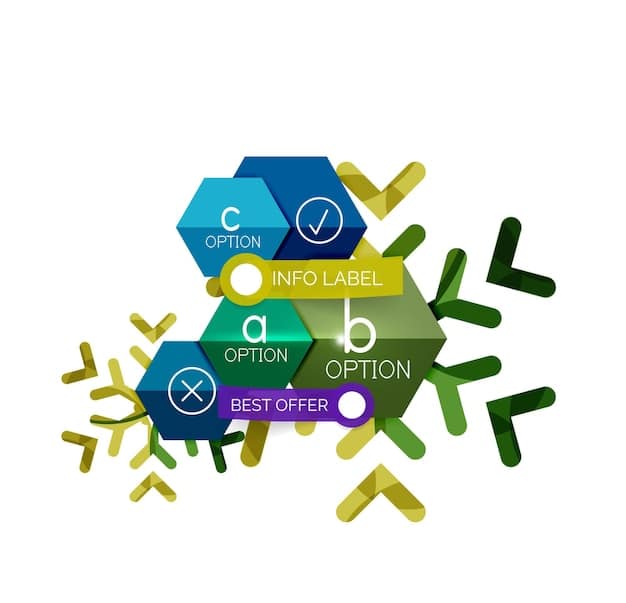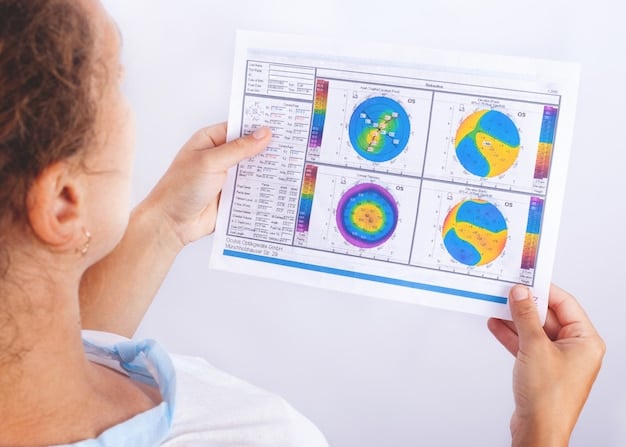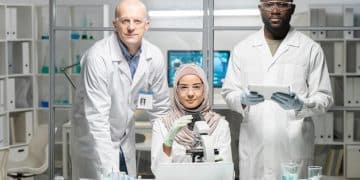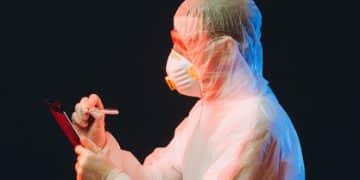Navigating US Biotech Events: Biologics and Biosimilars Regulatory Changes

US Biotech Events offer crucial insights into the evolving regulatory landscape for biologics and biosimilars. Understanding these changes is essential for companies navigating the complexities of bringing new therapies to market in the United States.
Navigating the complex regulatory landscape for biologics and biosimilars in the United States requires staying informed and proactive. US Biotech Events: How to Navigate the Evolving Regulatory Landscape for Biologics and Biosimilars are key opportunities to learn about the latest developments, network with industry experts, and strategize for future success.
Understanding the US Regulatory Framework for Biologics and Biosimilars
The US regulatory framework for biologics and biosimilars is a multifaceted system, evolving rapidly to keep pace with scientific advancements and market demands. These events offer a deep dive into the intricacies of FDA regulations, approval pathways, and ongoing challenges in this field.
Key Regulatory Bodies and Their Roles
Several key regulatory bodies play pivotal roles in overseeing biologics and biosimilars in the US, the most prominent of them being the Food and Drug Administration (FDA). Other important organizations include the Federal Trade Commission (FTC) and various congressional committees.
- FDA’s Center for Drug Evaluation and Research (CDER): Responsible for reviewing and approving new biologics and biosimilars.
- FDA’s Center for Biologics Evaluation and Research (CBER): Oversees the safety and effectiveness of biological products, including vaccines, blood products, and gene therapies.
- Federal Trade Commission (FTC): Monitors competition within the biologics and biosimilars market to prevent anti-competitive practices.
Understanding the roles of these bodies is crucial for anyone operating in the biologics and biosimilars space. The FDA, in particular, sets the standards and requirements that must be met for product approval and market entry.
In summary, the US regulatory framework is complex and involves multiple key players. Staying informed about the latest developments and understanding the roles of these regulatory bodies is essential for successfully navigating this landscape.
The Impact of Recent Legislation on Biotech Regulations
Recent legislation has significantly altered the landscape for biotech regulations, especially concerning biologics and biosimilars. Understanding these changes is crucial for biotech companies to stay compliant and competitive.
The Biologics Price Competition and Innovation Act (BPCI Act)
The BPCI Act, enacted in 2010, created an abbreviated approval pathway for biosimilars, similar to the Hatch-Waxman Act for generic drugs. This act has had a profound impact on the market for biologics and biosimilars.
The BPCI Act’s main objectives include:
- Encouraging competition by allowing biosimilars to enter the market more quickly.
- Balancing innovation by providing a period of exclusivity for reference biologics.
- Ensuring patient safety by requiring biosimilars to demonstrate they are highly similar to the reference product.
The BPCI Act has sparked debate regarding the balance between incentivizing innovation and promoting competition, leading to ongoing discussions about patent protection and market exclusivity periods.

In conclusion, recent legislation, particularly the BPCI Act, has reshaped the regulatory landscape for biologics and biosimilars. Companies must adapt to these changes to ensure compliance and maintain a competitive edge.
Strategies for Successful Biosimilar Development and Approval
Developing and gaining approval for biosimilars involves a strategic approach that carefully considers regulatory requirements and market dynamics. Attendees at US Biotech Events gain insights into best practices for navigating this complex process.
Analytical Characterization and Comparability Studies
Analytical characterization is the cornerstone of biosimilar development. Comprehensive comparability studies are essential to demonstrate that the biosimilar is highly similar to the reference product in terms of structure, function, and purity.
Clinical Trial Design and Execution
Well-designed clinical trials are critical for demonstrating biosimilarity and ensuring patient safety. Key considerations in clinical trial design include:
- Selecting appropriate patient populations.
- Choosing relevant endpoints.
- Minimizing immunogenicity risks.
- Employing sensitive and reliable assays to detect differences between the biosimilar and the reference product.
Effective clinical trial execution requires meticulous planning, rigorous data collection, and stringent quality control measures.
In summary, a successful biosimilar development and approval strategy requires a deep understanding of regulatory requirements, robust analytical characterization, and well-executed clinical trials. These events provide valuable insights into the latest trends and best practices in biosimilar development.
The Role of Real-World Evidence in Biologics and Biosimilars
Real-world evidence (RWE) is increasingly playing a pivotal role in the evaluation and regulation of biologics and biosimilars. The use of RWE can provide valuable data on the long-term safety and effectiveness of these products in diverse patient populations.
Sources and Applications of Real-World Evidence
RWE can be gathered from a variety of sources, including electronic health records (EHRs), claims data, patient registries, and mobile health technologies. These data sources can be used to:
- Monitor the safety and effectiveness of biologics and biosimilars in real-world settings.
- Identify potential adverse events or unexpected outcomes.
- Compare the performance of different biologics and biosimilars.
The FDA is actively exploring ways to incorporate RWE into its regulatory decision-making processes, potentially leading to more efficient and patient-centered evaluations.

In conclusion, real-world evidence is becoming increasingly important in the evaluation of biologics and biosimilars. By leveraging RWE, regulators and manufacturers can gain a more comprehensive understanding of the safety and effectiveness of these products in real-world settings, ultimately benefiting patients and healthcare systems.
Challenges and Opportunities in the Biosimilars Market
The biosimilars market presents both significant challenges and exciting opportunities for companies involved in the development, manufacturing, and commercialization of these products. US Biotech Events offer a platform to discuss strategies for overcoming obstacles and capitalizing on market potential.
Market Access and Reimbursement Hurdles
Gaining market access and securing favorable reimbursement policies are critical challenges for biosimilar manufacturers. These hurdles often involve:
- Navigating complex payer landscapes.
- Demonstrating cost-effectiveness to healthcare providers and insurers.
- Addressing physician and patient perceptions about biosimilar safety and efficacy.
Innovative pricing strategies and effective communication campaigns are essential for overcoming these challenges.
Despite these challenges, the biosimilars market offers tremendous opportunities for companies that can navigate the regulatory and commercial landscape effectively. The growing demand for affordable medicines and the increasing acceptance of biosimilars by healthcare providers and patients are creating a favorable environment for biosimilar adoption. Events focusing on US Biotech Events provide a venue to discuss the economic impacts within the industry.
Future Trends in Biologics and Biosimilars Regulation
The regulatory landscape for biologics and biosimilars is constantly evolving, driven by scientific advancements, technological innovations, and changing healthcare needs. Staying ahead of these trends is essential for ensuring long-term success in this dynamic field.
Emerging Technologies and Regulatory Implications
Emerging technologies such as gene editing, cell therapies, and personalized medicine are poised to revolutionize the treatment of many diseases. These innovations also present new regulatory challenges, requiring adaptable and forward-thinking approaches.
Potential future trends include
- Increased emphasis on data sharing and transparency.
- Development of more sophisticated analytical techniques for assessing biosimilarity.
- Greater collaboration between regulators, manufacturers, and healthcare providers to accelerate the development and approval of innovative therapies.
Preparing for these future trends will be crucial for companies seeking to remain competitive in the biologics and biosimilars market. By embracing innovation and proactively engaging with regulators, companies can help shape the future of biologics and biosimilars regulation.
| Key Point | Brief Description |
|---|---|
| 🔑 Regulatory Framework | Understanding the US FDA's role in biologics and biosimilars approval. |
| 🔬 Biosimilar Development | Strategies for successful analytical characterization and clinical trials |
| 📈 Market Challenges | Overcoming market access and reimbursement hurdles for biosimilars. |
| 🔮 Future Trends | Emerging technologies and their regulatory implications for biologics. |
FAQ
Biologics are complex drugs derived from living organisms, while biosimilars are highly similar versions of these biologics that have no clinically meaningful differences in terms of safety and efficacy.
These events provide crucial insights into the industry, regulatory updates, networking, and strategic opportunities for biotech companies operating in the United States.
The BPCI Act created an abbreviated approval pathway for biosimilars, fostering competition while balancing innovation for reference biologics, and also ensures patient safety.
Real-world evidence can provide useful data for monitoring the safety and effectiveness of both biologics and biosimilars in diverse patient populations in practical settings.
Key challenges for biosimilars include market access, reimbursement hurdles, and addressing perceptions regarding biosimilar safety and efficacy amongst healthcare providers.
Conclusion
Navigating the regulatory landscape for biologics and biosimilars requires continuous learning and adaptation. US Biotech Events serve as invaluable resources for industry stakeholders seeking to stay informed, network with peers, and develop effective strategies for success in this dynamic and impactful field.





